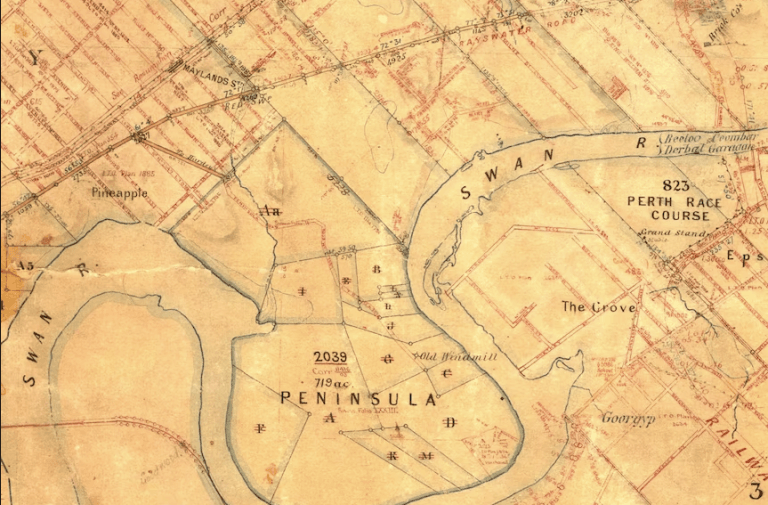History of Maylands
Original Inhabitants
The Maylands area was inhabited by the Noongar people for thousands of years prior to British arrival. The Derbal Yerrigan is a sacred place for Noongar people being created by the Waugal (a Dreamtime Creation Spirit). The river has many meeting places where indigenous peoples would gather as they travelled from place to place. It also served as a source of nourishment.
Early Settlement
Following the founding of the Swan River Colony in 1829 boating parties of Captain Stirling passed through a shallow passage to the Perth water, and then on to Maylands, and the upper Swan. Within a few months the Peninsula area was settled and farmed by the Tranby Settlers, led by Joseph Hardey.
Floods destroyed the two residences Joseph Hardey constructed before the current Tranby House was built in 1839.
Hardey and his family were soon well established both as farmers, and as devout and active leaders of the Methodist Church. They eventually owned all the land on the Peninsula. From 1830 to 1900 Maylands was mainly known for agricultural products. The Peninsula produced many fine crops of corn, wheat fruit and wine, taking prizes in the Melbourne show for dried fruit and wine.
However, from the 1880s and 1890s there was significant industrial development with the establishment of the Maylands Brickworks (1885) and the Ferguson Foundry (1898), which was crucial for the Goldfields Water Supply Scheme.
Industry brought significant population growth as families moved into the area and men worked in the pipe foundry and brickworks.
The construction of the Maylands Railway Station in 1900 and the surrounding infrastructure led to the growth of the local shopping precinct and the absorption of the adjacent peninsula into the suburb.
The area around the train station was originally called Falkirk. Although the peninsula land area was known as Maylands for some time, Falkirk was renamed as Maylands and the area has been known as this until now. How the name Maylands was chosen is a source of conjecture among historians.
Urbanisation
The increased population resulted in the town centre growing to include pubs, tea rooms, grocery stores, chemists, real estate agents among many new businesses and many weatherboard cottage homes.
The land area housing the Ferguson Foundry has been rezoned residential and developed by the State Government into a housing estate. The names of the streets reflect its history with Foundry Street one of them and Falkirk Park the name of the estate and the park located in the development. Three early hotels were Central Hotel 1902, Peninsula Hotel 1903 and Hoffman’s Hotel. The Peninsula Hotel is now State Heritage listed and houses a DOME café.
Maylands Primary School was established in 1903, Maylands Hall was built in 1920 and the War Memorial Cenotaph in 1921. The Maylands Hall, once a place of movie nights and dances, became the Maylands Library and currently houses the West Australian Youth Jazz Orchestra.
World War I and II had significant effects on the townships along the Midland rail line, of which Maylands is one. Many young men went to war from these towns and many did not survive. From news articles of the times it appears there were too frequent and too many announcements of more lives lost. In Perth, a community group named the Ugly Men’s Association formed during WWI to support returned soldiers, widows and their families. There was a Maylands branch of this Association, and they met regularly at the Masons Hall. By WWII the Government had set up support networks for returned soldiers, widows and their families. The War Cenotaph now has a plaque recognising indigenous peoples who served their country and is the location for the Maylands annual ANZAC service.
The Maylands Primary School building now houses the West Australian School of Instrumental Music.
The Victorian Institute and Industrial School for the Blind commenced construction in 1898 in Maylands. The buildings contained a factory, workshops and some residences. In 1932 the building was renamed The West Australian Institute and Industrial School for the Blind and in 1937 the Lotteries Commission and the government funded the construction of extra buildings and joined the original buildings together. This building has been repurposed and renovated and is now a world class facility that houses the West Australian Ballet Centre.
Trams serviced Maylands along Guildford Road from 1934 until they were decommissioned in 1958.
Maylands Aerodrome
In 1924 the Commonwealth Government built the Maylands Aerodrome located on the Maylands Peninsula. It was the first commercial aerodrome in Western Australia. Charles Kingsford-Smith landed at the Aerodrome on the first trans Australia flight. The Aerodrome closed in 1963 due to its inability to cope with larger aircraft and Perth Airport overtook its services. A historic hanger from the Aerodrome remains in situ on the peninsula and is used by the Western Australian Police Department. A memorial is located on the peninsula at the old Aerodrome site to commemorate the people and happenings at the Aerodrome. It is open to the public.
A pictorial history of Perth’s first licenced aerodrome which operated from 1924 until 1963 can be viewed by clicking here GEOFF GOODALL’S AVIATION HISTORY SITE
Modern Maylands
Maylands was part of the City of Stirling until 1998, when boundary changes made it part of the City of Bayswater.
Today, Maylands is known for its heritage-listed buildings, vibrant street art, and its diverse arts and culture scene, including the West Australian Ballet Company and Western Australian Youth Jazz Orchestra.
